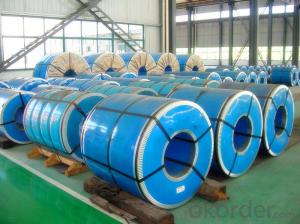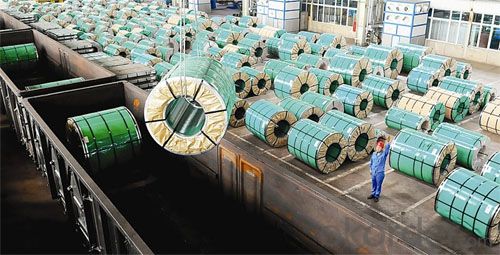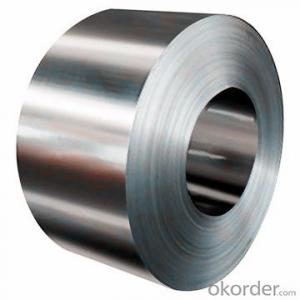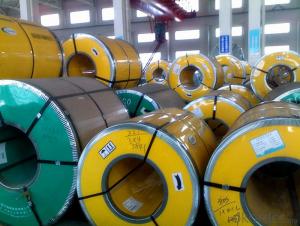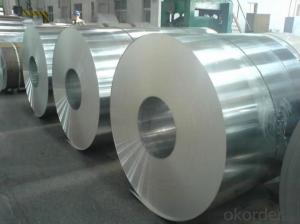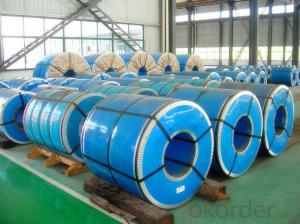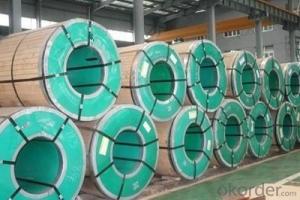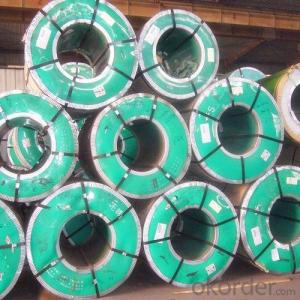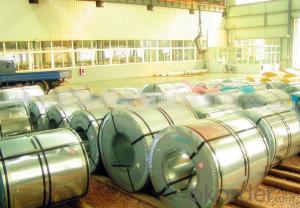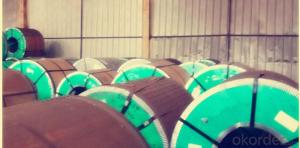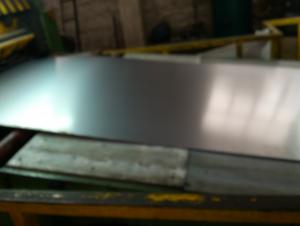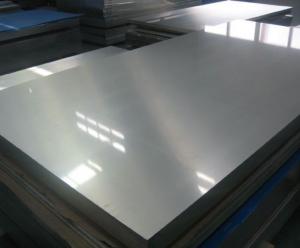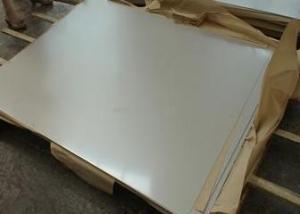Hot Rolled Stainless Steel Coil 304 Wide Strip No.1 Finish
OKorder Service Pledge
OKorder Financial Service
You Might Also Like
Type | Hot Rolled Stainless Steel Coil 304 Wide Strip No.1 Finish |
Thickness | 2.5mm-4.0mm |
Width | 1000mm, 1219mm, 1240mm, 1500mm |
Length | according to weight |
Brand name | CNBM |
Standard | ASTM, AISI, DIN, GB, JIS etc |
Material | 304 |
Application | Foodstuff, Gas, metallurgy, biology, electron, chemical, petroleum, boiler, nuclear energy, Medical equipment, fertilizer etc |
Package | Standard export sea-worthy packing |
Delivery time | Within 15 days since getting the deposit or LC origin |
Surface | No.1 |
Productivity | 20000 tons/month |
Hot Rolled Stainless Steel Coil 304 Wide Strip No.1 Finish Chemical Composition:
(%):C=0.07, Mn=2.00, P=0.045, S=0.030, Si=0.075, Cr=17.5-19.5, Ni=8.0-10.5, N=0.10
Hot Rolled Stainless Steel Coil 304 Wide Strip No.1 Finish Physical Properties
Tensile strength σb (MPa) ≥ 520
The conditions yield strength σ0.2 (MPa) ≥ 205,
Elongation δ5 (%) ≥ 40
Reduction of ψ (%) ≥ 50,
Hardness: ≤ 187
HB; ≤ 90
HRB; ≤ 200H
- Q: Can stainless steel strips be used in high-pressure applications?
- Yes, stainless steel strips can be used in high-pressure applications. Stainless steel is known for its strength, durability, and corrosion resistance, making it suitable for withstanding high-pressure environments.
- Q: Are stainless steel strips non-magnetic?
- Stainless steel strips are typically not magnetic, although the magnetic characteristics of stainless steel can differ depending on the specific alloy and composition. The commonly used stainless steel types, like 304 and 316, do not possess magnetic properties when in their annealed condition, meaning they do not attract or retain a magnetic charge. This quality makes them suitable for various applications where magnetism is unwanted. However, certain stainless steel alloys, such as ferritic grades, may display magnetic properties due to their higher iron content. Therefore, it is essential to take into account the specific type of stainless steel when assessing its magnetic attributes.
- Q: Can stainless steel strips be used in heat exchangers?
- Yes, stainless steel strips can be used in heat exchangers. Stainless steel is a common material used in heat exchangers due to its excellent corrosion resistance, high heat transfer efficiency, and ability to withstand high temperatures. Stainless steel strips offer flexibility in design and can be easily formed into various shapes, making them suitable for heat exchanger applications.
- Q: Can stainless steel strips be electroplated?
- Yes, stainless steel strips can be electroplated. Electroplating is a process in which a thin layer of metal is deposited on the surface of an object using an electric current. While stainless steel is already corrosion-resistant, electroplating can enhance its appearance, provide additional protection against wear and tear, and improve its conductivity. The process involves immersing the stainless steel strip in a bath containing a solution of metal ions and applying an electric current, causing the metal ions to be attracted and deposited onto the surface of the strip. This can be done with various metals, such as gold, silver, nickel, or chromium, to achieve different aesthetic or functional properties.
- Q: Can 111 stainless steel strips be stamped or embossed for decorative purposes?
- Certainly! It is possible to stamp or emboss 111 stainless steel strips for decorative intentions. Stainless steel is an adaptable substance that can undergo different manufacturing procedures, including stamping and embossing. The process of stamping entails pressing or molding the stainless steel strip with a die, whereas embossing generates elevated or sunken designs on the surface. Both methods can be employed to incorporate decorative patterns, logos, or textures onto the stainless steel strips, rendering them appropriate for decorative purposes in various industries like interior design, architecture, automotive, or consumer goods.
- Q: What are the recommended safety guidelines for cutting 111 stainless steel strips?
- When cutting 111 stainless steel strips, it is important to follow recommended safety guidelines to minimize the risk of injury. Here are some guidelines that are commonly recommended: 1. Personal Protective Equipment (PPE): Always wear appropriate PPE such as safety glasses or goggles to protect your eyes from flying debris, and gloves to protect your hands from sharp edges or potential cuts. 2. Use the Right Tools: Ensure that you are using the correct cutting tool for stainless steel strips. This could include tools like a metal cutting circular saw or a plasma cutter. Make sure the tool is in good condition and properly maintained. 3. Secure the Material: Secure the stainless steel strip properly before cutting to prevent movement or slipping during the process. This can be achieved by using clamps or a vise to hold the strip securely in place. 4. Clear the Work Area: Ensure that the work area is clean and free of any obstructions or hazards that could cause accidents. Remove any loose objects or debris that could interfere with the cutting process. 5. Follow Proper Technique: When cutting, use a steady and controlled motion to prevent the tool from binding or jumping. Always cut away from your body and avoid any sudden movements that may result in injury. 6. Watch for Heat Build-up: Cutting stainless steel can generate a significant amount of heat. Be cautious of this heat build-up and avoid touching the material immediately after cutting to prevent burns. 7. Allow for Cooling: After cutting, allow the stainless steel strip to cool down before handling it further. This will reduce the risk of burns and ensure safe handling. 8. Proper Disposal of Waste: Dispose of any waste material, such as scraps or cuttings, in appropriate containers or designated areas to prevent accidents or injuries. It is important to note that these guidelines may vary depending on the specific cutting method and equipment being used. Always refer to the manufacturer's instructions and seek professional advice if necessary to ensure the highest level of safety when cutting stainless steel strips.
- Q: Can stainless steel strips be used in the pharmaceutical industry?
- Indeed, the pharmaceutical industry can make use of stainless steel strips. Owing to its remarkable resistance to corrosion, as well as its hygienic and durable properties, stainless steel is a highly favored material in pharmaceutical manufacturing. It is frequently employed in pharmaceutical equipment and machinery, encompassing tanks, mixers, conveyors, and packaging machines. Furthermore, stainless steel strips are utilized in the construction of cleanrooms and laboratory furniture due to their convenient cleanability and ability to withstand intense cleaning agents. Moreover, these strips meet the strict regulatory standards of the pharmaceutical industry, guaranteeing the secure production of drugs and pharmaceutical products.
- Q: What are the factors affecting the electrical conductivity of 111 stainless steel strips?
- The electrical conductivity of 111 stainless steel strips can be influenced by various factors. Firstly, the alloy composition of the stainless steel plays a significant role. The type and amount of elements present in the alloy can greatly affect conductivity. For example, the inclusion of elements like chromium, nickel, and manganese can enhance conductivity, while elements like carbon can decrease it. Additionally, the heat treatment process used during manufacturing can also impact conductivity. By altering the microstructure of the material, heat treatment can affect the movement of electrons within the strips. The grain size and orientation of the strips are important considerations as well. Smaller grain sizes and a more uniform grain orientation generally result in higher conductivity as they allow for better electron flow. Furthermore, the surface condition of the strips can affect conductivity. Factors such as roughness, contamination, or oxidation can impede the flow of electrons, leading to decreased conductivity. Temperature is another crucial factor. As temperature increases, the thermal vibrations of atoms intensify, hindering the movement of electrons and decreasing conductivity. Impurities and defects within the strips can also impact conductivity. Impurities introduce additional scattering centers for electrons, while defects like dislocations hinder electron flow, resulting in reduced conductivity. Lastly, mechanical deformation, such as rolling or stretching, can modify the crystal structure of the strips and introduce dislocations, thereby influencing the movement of electrons and impacting conductivity. It is important to note that the specific combination and interaction of these factors will ultimately determine the electrical conductivity of 111 stainless steel strips.
- Q: Can 111 stainless steel strips be used in nuclear power plants?
- Yes, 111 stainless steel strips can be used in nuclear power plants. Stainless steel is commonly used in nuclear power plants due to its corrosion resistance, high strength, and good mechanical properties. The specific grade of stainless steel, such as 111, may vary depending on the application and the specific requirements of the nuclear power plant. However, it is worth mentioning that stainless steel is not used in all components of a nuclear power plant, and other materials may also be used depending on the specific needs and regulations.
- Q: Can 111 stainless steel strips be used in high-temperature applications?
- 111 stainless steel strips are not suitable for high-temperature applications. It is a type of stainless steel with low carbon content, commonly used for general purposes. Its maximum operating temperature is approximately 400-450 degrees Celsius (750-840 degrees Fahrenheit). To ensure adequate heat resistance and oxidation resistance at elevated temperatures, it is advisable to utilize stainless steel grades like 310, 316, or 321, which possess higher levels of chromium and nickel.
Send your message to us
Hot Rolled Stainless Steel Coil 304 Wide Strip No.1 Finish
OKorder Service Pledge
OKorder Financial Service
Similar products
Hot products
Hot Searches
Related keywords
